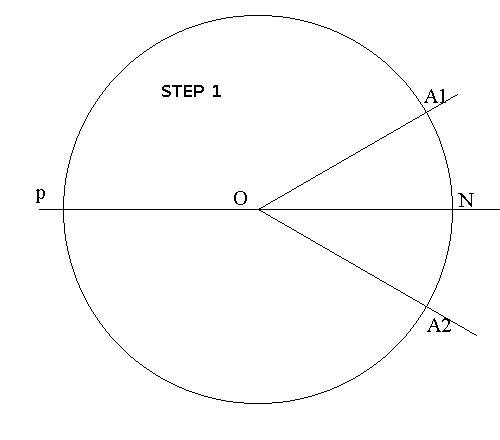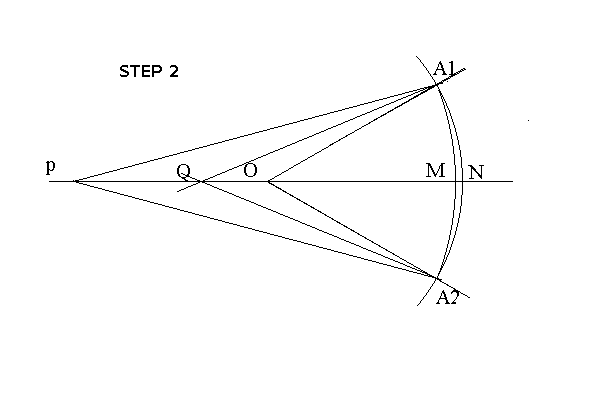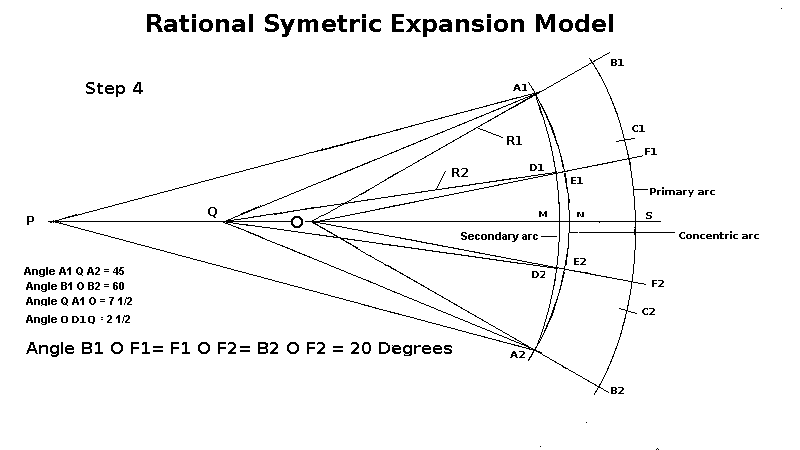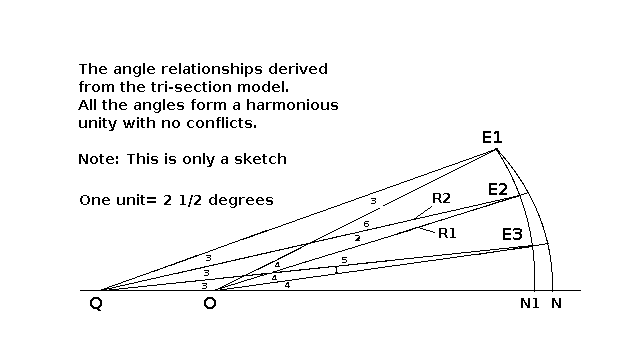
|
' Therefore you cannot construct an exact one-degree angle with ruler and compass! ' Anonymous Teacher " And there shall be no more curse: but the throne of God and of the Lamb shall be in it; and his servants shall serve him: " INTRODUCTION Take a compass and draw a circle using
any radius. Now without changing the radius,
mark off as many segments as is possible on the
circumference of the circle. The result will be
a hexagon, a six sided polygon. The circle has been
divided into six equal segments using only a compass.
Now if i where to suggest to you, that we should
therefore also be able to divide one of the six
segments, into six equal segments, using our compass,
as well as an unmarked straightedge, this should not
be a daunting task. This will then enable us to
divide the circle into 360 equal segments(degrees),
and we will have an instrument (protractor), that we
can use for the purpose of indicating direction. Your
teacher will tell you this is not possible, however he
is mistaken.
The purpose of this essay is to show the reader how to make a 360 degree instrument(protractor) from first principles, using only a compass and an unmarked straightedge. In order to accomplish this we will proceed to divide one of the six segments that we have already made, into six equal segments. We will then see that having done this, we are able to construct our 360 degree protractor without any difficulty. STEP BY STEP INSTRUCTIONS TO TRISECT ANY ANGLE |

STEP TWO
Connect A1 P and
A2 P.
Bisect angle P A1 O and angle P
A2 O.
Q is where the bi-sections cut
the axis.
With radius A1 Q draw the
secondary arc A1 M A2.

STEP
THREE
Set your compass to QO and mark off
MS.
With
radius OS draw the primary arc B1 S B2.

STEP
FOUR
This is a very simple process and only
involves a few steps.
Bi-sect B1 S1 and B2 S2 to get C1 and C2.
Use B2 C2 to divide the secondary arc at D1 and
D2.
A2 D2, D2 D1, and D1 A1 are each fifteen
degrees.
Connect Q and D1 , as well as Q and D2.
Connect O and D1 and extend to E1 and F1.
Connect O and D2 and extend to E2 and F2.
B2 F2, B1 F1 and F1 F2 divide
the primary arc into three equal portions of
twenty degrees.

How it works
The model uses the principle of
proportion to trisect a given angle.
The basic model expands a 45 degree angle by
1/3 (15 Degrees) to 60 degrees.
The model can expand any angle up to 45
degrees by one third.
The tri-section of a 60 degree angle is used
in the example above.
The procedure is as follows:
Three parts(15d each) of the primary arc is
transferred to the secondary arc.
Two parts of 15 degrees is then expanded by
one third to 20 degrees.
I refer to the model as the rational
symmetric expansion(RSE) model.

The Principle of
Proportion applied (Proof)
The model uses the
principle of proportion as derived
from the standard model.
Then:
Angle A1 P O = 15 degrees
Angle A1 O N = 30 degrees
The ratios are 1:2
Let angle E1 O N = z degrees
Then:
Angle E1 P O = 1/2 z degrees
Angle E1 O N = z degrees
The ratios are 1:2
According to the law of proportion the
relationship between the angles
remains constant as E1 moves between
A1 and N.
The radius O E1 and O A1 remain
constant.
The sum of the angles of triangle P A1
O are 180 degrees, and the sum of the
angles at O, for the straight line is
also 180 degrees.
the revised
model.
With the
revised model we move point P to Q.
The constant radius is lengthened from O
A1 to Q A1, and Q E2.
The relationship between angles are now
as follows:

Angle Q A1 O = 7 1/2 degrees
Angle A1 Q N = 22 1/2 degrees
Angle A1 O N = 30 degrees
The ratios are 1:3:4
Let angle E2 O N be Z degrees. The
relationship between the angles of spike
Q E2 O will be as follows:
Angle Q E2 O = 1/4 z degrees
Angle E2 Q N = 3/4 z degrees
Angle E2 O N = z degrees
The ratios are 1:3:4
This relationship between the angles
will remain constant as E2 moves between
A1 and N1.
The radius Q A1 and Q E2 remain
constant.
In any rational
system the principle of cause and effect
applies, and being a closed system
nothing can be added or taken away from
the system.
A RATIONAL SYSTEM OF ANGLES
The
sketch
below
shows
the
relationships between all the angles
of the model we used to tri-sect
the 30 degree angle. To simplify the
angles, one unit represents 2 1/2
degrees.

Note:
All illustrations are only sketches.
We
construct a pentagon using the
same circle(radius) we used for
our hexagon.
The pentagon has five equal
sides of 72 degrees.
We now sub divide the 72 angle
three time, giving us a 9
degrees angle.
The one degree angle is derived
from the difference between the
9 and 10 degree angles.
CONCLUSION.
It is possible to construct a 360 degree protractor from first principles, using only a compass and unmarked straightedge.
For those who still have doubts, click here.